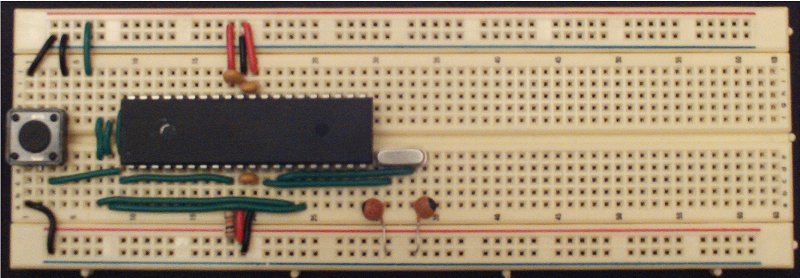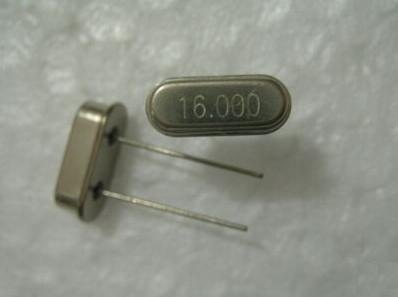
Parts
Breadboard

Atmega644

16MHz crystal

momentary switch

4 x .1uF capacitor
2 x 22pF capacitor

10K resistor

And some wire.
Put the bread board down vertically. Row 1 at top, blue rail left, red rail right.
Place the 644p into the bread board. Pin 1 into bread board hole 10D.
Place the momentary switch's pins into bread board 1D, 1F, 3D, and 3F.
Place the crystal into rows 31E and 33E
Place a .1 uF cap from 9E to 9F. This is the reset on RTS cap. We'll be "building" a serial port on the left side, rows 4-9.
Place a .1 uF cap from 18I to 19I. Decouple AREF from AGND.
Place a .1 uF cap from 19I to 20I. Decouple AVCC from AGND. Yep, 19I, has 2 cap leads in it. It's a tight fit but can be done.
Place a .1 uF cap from 19C to 20C. Decouple VCC from GND.
Place 10K resistor from left VCC rail to 18A. This is the pull up resistor for RESET. Strictly speaking it isn't necessary. The 644p has an internal pull up resistor. But it's a little tiny one. Common practice seems to be to use a bigger one off chip.
Place a 22pf capacitor from left GND rail to 31A.
Place a 22pf capacitor from left GND rail to 33A.

** Wires **
1A to left GND. Part of the reset circuit from momentary switch to ground. Pressing switch connects reset to ground, resetting the chip. Also bridges GND from left GND rail to right GND rail through momentary switch.
1J to right GND rail.
3C to 9B. This will carry RESET from the RESET cap to the momentary switch.
4J to GND. Carry GND to serial port.
6J to VCC. Carry VCC to serial port.
7A to 23A, and 7E to 7G. Bring Rx to serial port.
8A to 24A, and 8E to 8G. Bring Tx to serial port.
9C to 18C. Bring RESET from chip to reset cap.
18J to right VCC. AREF.
19A to left VCC, chip VCC.
19J to right GND. AGND.
20A to left GND, chip GND.
20J to right VCC. AVCC.
21C to 31C. XTAL from chip to crystal.
22C to 33C. XTAL from chip to crystal.
Serial "port" is on the breadboard side B, column h, rows 4-9. FTDI USB cable black wire to row 4, green to row 9.
The FTDI cable has a female header. The short side of a male header is too short to fit into the breadboard. Easiest if you have them, is to use double length male headers to connect FTDI female connector to bread board hole. More likely you'll need to take two of the 6 pin male headers, and solder the short legs to each other. See the picture. Normally I use shrink fit tubing over bare wire after I solder to protect against shorts. But, there's no way to get them on in this case. So just solder REAL carefully.
To use the serial port, plug the FTDI cable into your computer and into the double sided male header you just created, which in turn is placed into the breadboard.
ICSP "port" is on side A, column B, rows 15-20.
Both the AVR MK-ISP2 and the USBTiny use a 6 pin ICSP female header, in a 2 row by 3 pin configuration. We need to make a cable going from a 2x3 male header to a 1x6 male header. We need to make the following cable using text mode "art":
Note, we are looking at the 2x3 header from the bottom. That is, at the pins.
To construct this cable, use either a crimping tool or solder. If you solder, split the ribbon cable back far enough that you can get in a bit of heatshrink without it shrinking when you solder the wire to the short side of the pin. After the wire is soldered, pull down the heat shrink to cover the joint, then shrink the tubing.
To use the ICSP port, plug your programmer into your computer, and the converter cable you created above into the 2x3 female connector of the programmer's cable. Green pin is pin 1, black is pin 6. Now plug the 1x6 end of the converter cable into the breadboard. Grey pin in hole 15B, Black in hole 20B.
Tags:
Sanguino













Leave a comment